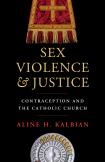Planning Family
With the ongoing concerns of the United States Conference of Catholic Bishops over the contraceptive mandate and the upcoming 2014 Synod of Bishops on challenges facing the family, which will include discussions on contraception, Aline Kalbian’s book is a timely and insightful contribution to this issue. It begins with a methodological explanation of the project (ch. 1), presents an historical overview of the justificatory strategies of Catholic teaching against contraception (ch. 2) and explores three case studies to illustrate ethical and conceptual frameworks and their interrelationship that guide contemporary Catholic teaching on contraception, which informs broader social and cultural discussions on sex, violence and justice (chs. 3-5).
Kalbian’s methodological point of departure uses a religious ethics framework which seeks, through feminist analysis, to gain insight into “the justificatory and rhetorical moves that a religious tradition makes as it responds to cultural and social forces.” Through this method, Kalbian pursues two goals. First, she explores how contraception shapes perceptions of sex, violence and justice. Second, her detailed historical and contextual analysis of the Catholic church’s arguments against contraception highlight various conversation partners that inform its teaching—theological, scientific, cultural and social—and overlapping principles of justification. Combined, these indicate the fluidity of justificatory schemes, even within a particular religious tradition.
Drawing heavily from John Noonan’s seminal historical study, Contraception, Kalbian explores the “variety of justifications” that have shaped Catholic discourse on contraception, especially since “Humanae Vitae.” These justifications focus on various contextual considerations and evaluative principles from the Decalogue—thou shalt not kill, thou shalt not commit adultery and thou shalt not steal. While the initial focus of Catholic teaching against contraception was on marital morality and procreation, it has evolved to include concerns for violence and justice. This historical overview indicates that, though the teaching against contraception has remained consistent, the justification for that teaching has evolved and continues to do so.
Kalbian uses three cases to illustrate “overlapping justifications” in Catholic teaching on contraception. The magisterium focuses its prohibition against condom use to prevent H.I.V./AIDS infection, even in the case of serodiscordant couples, on the principle guiding sexual morality to prevent promiscuity. Others have argued condom use may be a moral obligation on the basis of respect for life, justice and the common good. These two perspectives are distinguished by different principles and methods of justification. An inductive, casuistic method focusing on the principles of justice and respect for life seems more methodologically conducive to an ethical response to condom use in the case of H.I.V./AIDS than does the magisterium’s deductive, reductionist approach that focuses on the principle of sexual morality.
Whereas the magisterium emphasizes a deductive method and the principle of sexual morality to guide its response to H.I.V./AIDS and condom use, it uses an inductive method and the principle of justice to allow the use of emergency contraception in the case of rape. A methodological and contextual shift in the church’s perspective views rape as an act of violence. Since rape is not a marital sexual act it is not subject to the same criteria of evaluation as is a sexual act. Kalbian opines that this sensitivity to the classification of an act based on context has methodological implications for evaluating contraception in other contexts as well.
The third case focuses on contraception in the context of population and development and the principle of justice. Catholic social teaching on justice and the common good provides the evaluative framework for assessing population control. The church relies upon social, scientific and economic data to defend a “pronatalist” stance that encourages families to reproduce and argues against the effectiveness of contraception to regulate population growth.
I draw attention to two broader questions that Kalbian’s study raises, which need to be explored further and will shape ongoing conversations and justification strategies on contraception for the Catholic church in particular, and religious ethics, in general. The first question, which is of particular concern to feminist analysis, is the interrelationship between gender and power structures and their relationship with the church’s only approved method of contraception, natural family planning. According to church teaching, N.F.P. promotes “mutual love and decision making” between the spouses within the marital relationship. While this may be the ideal of a marital relationship, it does not reflect the cultural and relational context of the vast majority of married couples throughout the world whose relationships exist within, and are shaped by, patriarchal cultures. In this existential context, it may be oppressive for the church to prescribe an approach to regulating fertility that creates an undue burden, especially for women.
Second, justice and ecological concerns invite deeper reflection on the correlation between overpopulation, which the church denies, and climate change. Kalbian notes that Pope Benedict “is relatively silent about whether or not population growth is of serious concern.” This silence indicates a lacuna in the magisterium’s methodology and use of science to inform its normative teachings. There is substantial scientific evidence on the direct correlation between the increase in world population and the increase in carbon emissions that cause climate change. Furthermore, there is substantial evidence to indicate that contraception limits population growth and N.F.P. is an often ineffective means to regulate fertility. Patriarchy and climate change are just two issues surrounding contraception that invite urgent conversations within the Catholic church and have methodological implications for religious ethics that analyze the interrelationship between sex, violence and justice. Kalbian has done a great service in providing a methodological framework to systematically analyze and move such conversations forward.
This article also appeared in print, under the headline “Planning Family,” in the October 6, 2014, issue.








